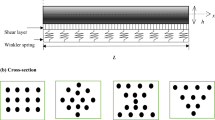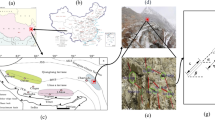Abstract
Functionally graded materials have many applications in engineering. Numerical simulation of structures made by these kinds of materials might be challenging since the properties of the materials are variable from point to point. Therefore, a pointwise numerical method may show better performance. In the present study, a mesh and integral free method is applied for the numerical simulation of Saint-Venant torsion problem in the prismatic bars, whose cross sections are made by functionally graded materials. Here, a simple method is presented to calculate the required integrals in the calculation of the torsional rigidity, in the context of a meshfree method. Thanks to the simplicity of the domain discretization in a meshfree method, cracked sections can be discretized simply using scatter nodes. In the presented vectorized formulation, the shear modules are assigned to each point in a section, which makes the procedure suitable for dealing with inhomogeneous sections. A benchmark problem is solved to validate the scheme. Some cracked sections are considered to investigate the effect of the characteristics of cracks in the torsional rigidity of prismatic bars according to their shear module functions.










Similar content being viewed by others
References
Afshar MH, Lashckarbolok M (2008) Collocated discrete least-squares (CDLS) meshless method: error estimate and adaptive refinement. Int J Numer Methods Fluids 56(10):1909–1928
Booker JR, Kitipornchai S (1971) Torsion of multilayered rectangular section. J Eng Mech Div ASCE 97(5):1451–1468
Chen Y-Z, Chen Y-H (1983) Third stress intensity factors of torsion crack bar with ring sections. Eng Fract Mech 17:87–94
Ecsedi I (2009) Some analytical solutions for Saint-Venant torsion of non-homogeneous cylindrical bars. Eur J Mech A Solids 28(5):985–990
Ely JF, Zienkiewicz OC (1960) Torsion of compound bars—a relaxation solution. Int J Mech Sci 1(4):356–365
Faal RT, Hassani AR, Milani AS (2012) Stress analysis of transversely isotropic sectors weakened by multiple defects. Int J Solids Struct 1(49):3627–3640
Fang-ming T, Ren-ji T (1993) Saint-Venant’s torsion problem for a composite circular cylinder with an internal edge crack. Appl Math Mech Ed 1(14):507–516
Firoozjaee AR, Afshar MH (2010) Adaptive simulation of two dimensional hyperbolic problems by collocated discrete least squares meshless method. Comput Fluids 39(10):2030–2039
Herrmann LR (1965) Elastic torsional analysis of irregular shapes. J Eng Mech Div ASCE (EM6) 11:9
Jaswon MA, Ponter AR (1963) An integral equation solution of the torsion problem. Proc R Soc Lond Ser A Math Phys Sci 273(1353):237–246
Kasikadelis JT, Sapountzakis EJ (1986) Torsion of composite bars by boundary element method. J Eng Mech 111(9):1197–1210
Lashckarbolok M, Jabbari E, Westerweel J (2015) A least squares based meshfree technique for the numerical solution the flow of viscoelastic fluids: a node enrichment strategy. Eng Anal Bound Elements 1:59–68
Liu GR (2002) MeshFree methods: moving beyond the finite element method. CRC Press, Boca Raton
Rongqiao X, Jiansheng H, Weiqiu C (2010) Saint-Venant torsion of orthotropic bars with inhomogeneous rectangular cross section. Compos Struct 92:1449–1457
Rooney FJ, Ferrari M (1995) Torsion and flexure of inhomogenous elements. Compos Eng 5(7):901–911
Yuanhan W (1990) Torsion of a thick-walled cylinder with an external crack: boundary collocation method. Comput Methods Appl Mech Eng 14:267–273
Author information
Authors and Affiliations
Corresponding author
Rights and permissions
About this article
Cite this article
Nikmehr, O., Lashkarbolok, M. A Numerical Investigation on the Torsional Rigidity of Bars with Functionally Graded Material (FGM) Cross Sections Weakened by Cracks. Iran J Sci Technol Trans Civ Eng 43, 117–123 (2019). https://doi.org/10.1007/s40996-018-0147-7
Received:
Accepted:
Published:
Issue Date:
DOI: https://doi.org/10.1007/s40996-018-0147-7




